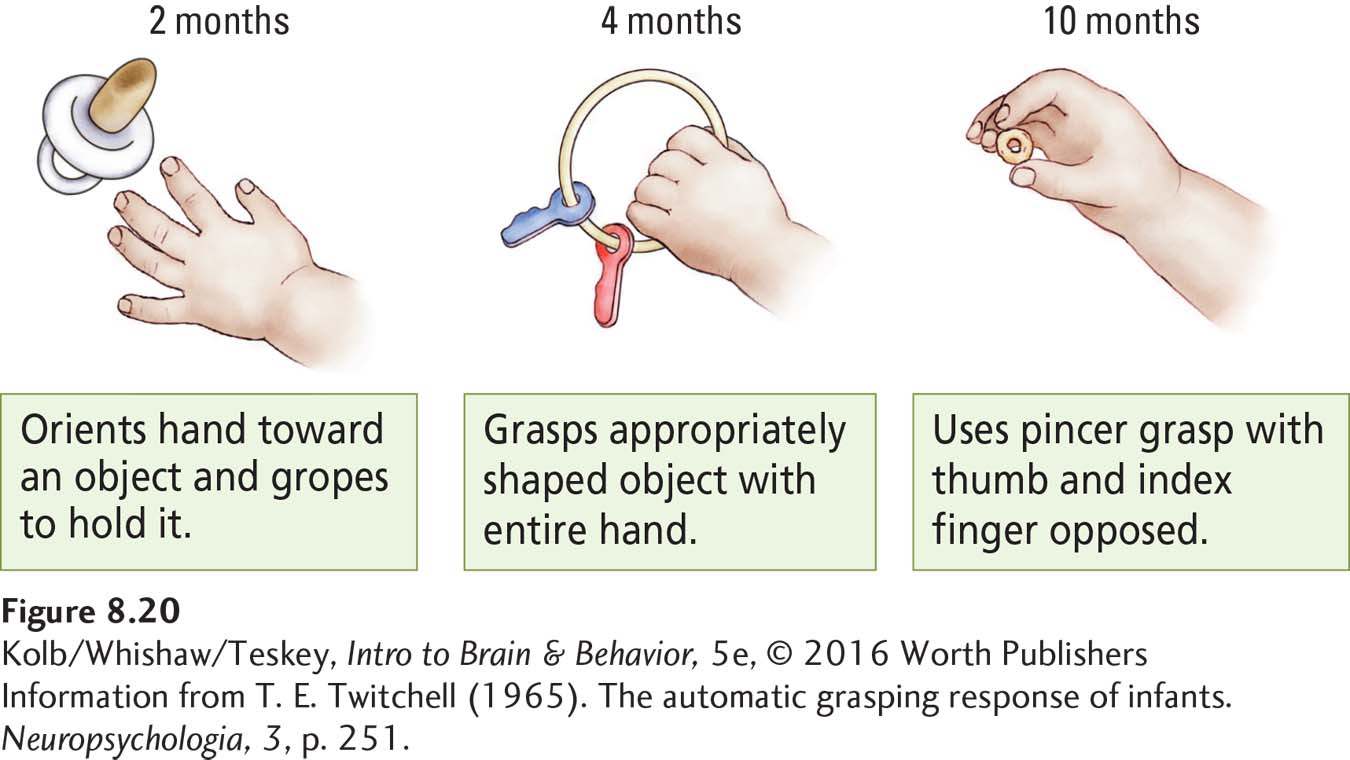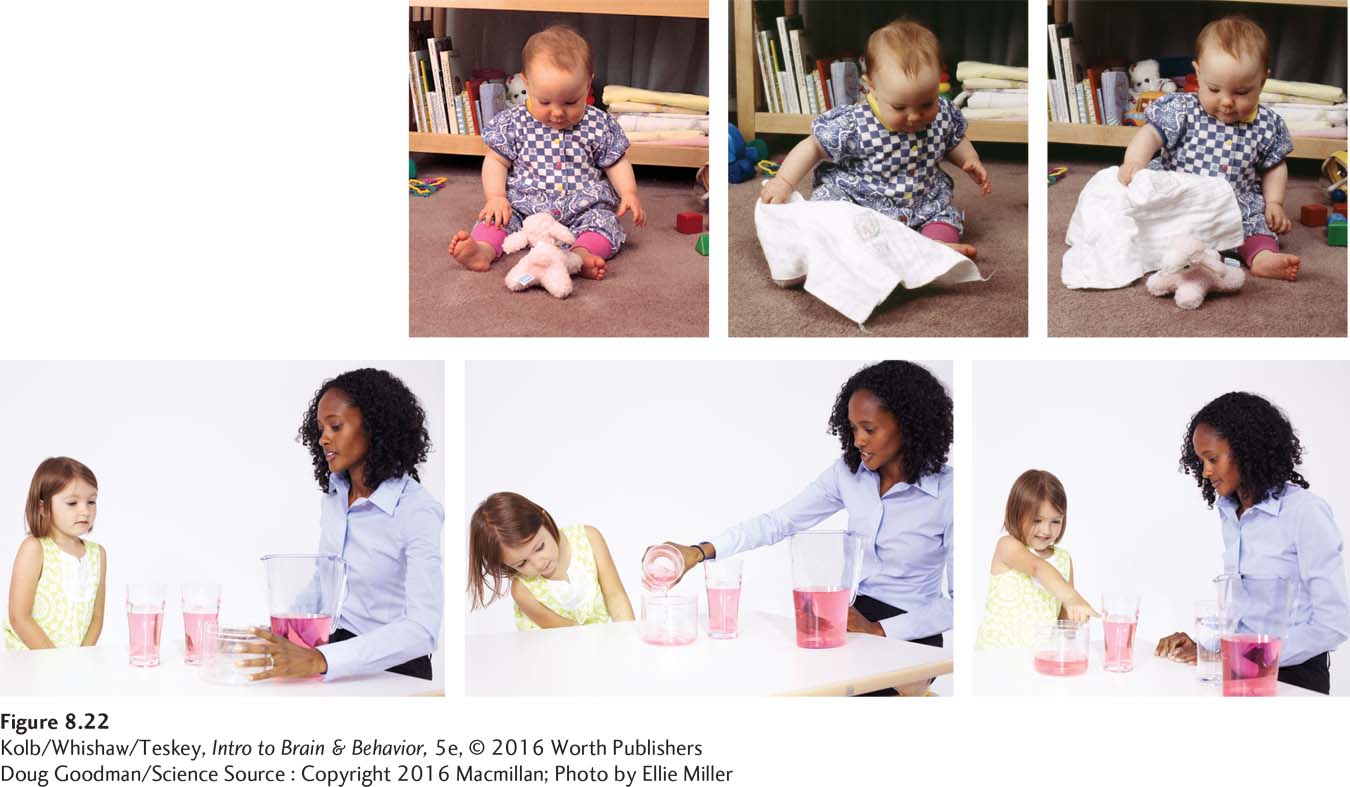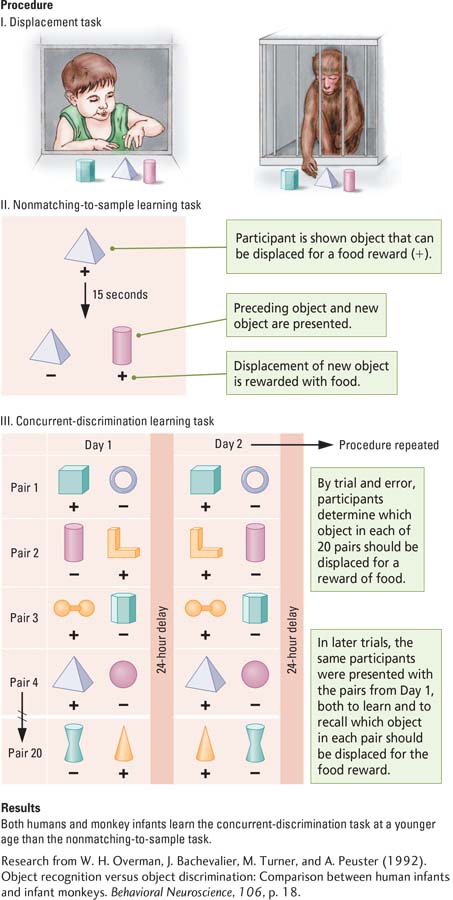8-3 Using Emerging Behaviors to Infer Neural Maturation
As brain areas mature, a person’s behaviors correspond to the functions of the maturing areas. Stated differently, behaviors cannot emerge until the requisite neural machinery has developed. When that machinery is in place, however, related behaviors develop quickly through stages and are shaped significantly by epigenetic factors.
Researchers have studied these interacting changes in the brain and behavior, especially in regard to the emergence of motor skills, language, and problem solving in children. We now explore development in these three areas.
Motor Behaviors
Developing locomotion skills are easy to observe in human infants. At first, babies cannot move about independently, but eventually, they roll over, then crawl, then walk.
Other motor skills develop in less obvious but no less systematic ways. Shortly after birth, infants are capable of flexing their arms in such a way that they can scoop something toward their body, and they can direct a hand, as toward a breast when suckling. Between 1 and 3 months of age, babies also begin to make spontaneous hand and digit movements consisting of almost all the skilled finger movements they will make as an adult, a kind of motor babbling.
These movements at first are directed toward handling parts of their body and their clothes (Wallace & Whishaw, 2003). Only then are reaching movements directed toward objects in space. Tom Twitchell (1965) studied and described how the ability to reach for objects and grasp them progresses in stages, illustrated in Figure 8-20.

Between 8 and 11 months, infants’ grasping becomes more sophisticated as the pincer grasp, employing the index finger and the thumb, develops. The pincer grasp is significant developmentally: it allows babies to make the very precise finger movements needed to manipulate small objects. What we see then, is a sequence in the development of grasping: first scooping, then grasping with all of the fingers, then grasping with independent finger movements.
261
If increasingly well-
A classic symptom of motor cortex damage, detailed in Section 11-1, is permanent loss of the pincer grasp.
In particular, a group of axons from motor cortex neurons myelinate at about the same time that whole-

We can now make a simple prediction. If specific motor cortex neurons are essential for adultlike grasping movements to emerge, removing those neurons should make an adult’s grasping ability similar to a young infant’s, which is in fact what happens.
Language Development
The gradual series of developments that accompanies speech acquisition has usually progressed significantly by age 3 or 4. According to Eric Lenneberg (1967), children reach certain important speech milestones in a fixed sequence and at constant chronological ages. Children start to form a vocabulary by 12 months. This 5-
Although language skills and motor skills generally develop in parallel, the capacity for language depends on more than the ability to make controlled movements of the mouth, lips, and tongue. Precise movements of the muscles controlling these body parts develop well before children can speak. Furthermore, even when children have sufficient motor skill to articulate most words, their vocabulary does not rocket ahead but rather progresses gradually.
A small proportion of children (about 1 percent) have typical intelligence and motor skill development, yet their speech acquisition is markedly delayed. Such children may not begin to speak in phrases until after age 4, despite an apparently healthy environment and the absence of any obvious neurological signs of brain damage. Because the timing of speech onset appears universal in the remaining 99 percent of children across all cultures, something different has likely taken place in the brain maturation of a child with late language acquisition. Specifying what that difference is—
262
Because the age of language onset is usually between 1 and 2 and language acquisition is largely complete by age 12, the best strategy considers how the cortex is different before and after these two milestones. By age 2, cell division and migration are complete in the language zones of the cerebral cortex. The major changes that take place from age 2 to 12 are in neuronal connectivity and myelination of the speech zones.
Changes in dendritic complexity in these areas are among the most impressive in the brain. Recall from Figure 8-12 that the axons and dendrites of the speech zone called Broca’s area are simple at birth but grow dramatically denser at age 15 to 24 months. This neuronal development correlates with an equally dramatic change in language ability, given that a baby’s vocabulary starts to expand rapidly at about age 2.
Focus 7-1 describes research on newborns’ reactions to language.
We can therefore infer that language development may be constrained, at least in part, by the maturing language areas in the cortex. Individual differences in the speed of language acquisition may be accounted for by differences in this neural development. Children with early language ability may have an early-
Results of MRI studies of the language cortex show that, in contrast with the thinning of motor cortex associated with enhanced dexterity shown in Figure 8-21A, a thickening of the left inferior frontal cortex areas associated with enhanced phonological processing (understanding speech sounds), as shown in Figure 8-21B. The unique association between cortical thickening and phonological processing is not due to a general relation between all language functions and cortical thickening, however. Figure 8-21C shows significant thinning of diffuse cortical regions associated with better vocabulary—
Development of Problem-
The first researcher to try to identify discrete stages of cognitive development was Swiss psychologist Jean Piaget (1952). He realized that he could infer children’s understanding of the world by observing their behavior. For example, a baby who lifts a cloth to retrieve a hidden toy shows an understanding that objects continue to exist even when out of sight. This understanding of object permanence is revealed by the behavior of the infant in the upper row of photographs in Figure 8-22.

Copyright 2016 Macmillan; Photo by Ellie Miller
263
An absence of understanding also can be seen in children’s behavior, as shown by the actions of the 5-
By studying children engaged in such tasks, Piaget concluded that cognitive development is a continuous process. Children’s strategies for exploring the world and their understanding of it are constantly changing. These changes are not simply the result of acquiring specific pieces of new knowledge. Rather, at certain points in development, fundamental changes take place in the organization of a child’s strategies for learning about the world and for solving problems. With these developing strategies comes new understanding.
Piaget identified four major stages of cognitive development, summarized in Table 8-2:
Stage I is the sensorimotor period, from birth to about 18 to 24 months of age. During this time, babies learn to differentiate themselves from the external world, come to realize that objects exist even when out of sight, and gain some understanding of cause and effect.
Stage II, the preoperational period, takes place at age 2 to 6 years. Children gain the ability to form mental representations of things in their world and to represent those things in words and drawings.
Stage III is the period of concrete operations, typically 7 to 11 years. Children learn to mentally manipulate ideas about material (concrete) things such as volumes of liquid, dimensions of objects, and arithmetic problems.
Stage IV, the period of formal operations, is attained sometime after age 11. Children are now able to reason in the abstract, not just in concrete terms.

If we take Piaget’s stages as rough approximations of qualitative changes that take place in children’s thinking as they grow older, we can ask what neural changes might underlie them. One place to look for brain changes is in the relative rate of brain growth.
After birth, brain and body do not grow uniformly but rather during irregularly occurring periods commonly called growth spurts. In his analysis of ratios of brain weight to body weight, Herman Epstein (1979) found consistent spurts in brain growth between 3 and 10 months (accounting for an increase of 30 percent in brain weight by age 18 months) as well as ages 2 to 4, 6 to 8, 10 to 12, and 14 to 16+ years. The increments in brain weight were about 5 percent to 10 percent in each of these 2-
264
EXPERIMENT 8-1
Question: In what sequence do the forebrain structures required for learning and memory mature?

Conclusion: Neural structures underlying the concurrent-
Brain growth takes place without a concurrent increase in the number of neurons, and so it is most likely due to the growth of glial cells, blood vessels, myelin, and synapses. Although synapses themselves would be unlikely to add much weight to the brain, their growth is accompanied by increased metabolic demands that cause neurons to become larger, new blood vessels to form, and new astrocytes to be produced for neuronal support and nourishment.
We would expect such an increase in cortical complexity to generate more complex behaviors, so we might predict significant, perhaps qualitative, changes in cognitive function during each growth spurt. The first four brain growth spurts Epstein identified coincide nicely with the four main stages of cognitive development Piaget described. Such correspondence suggests significant alterations in neural functioning with the onset of each cognitive stage.
At the same time, differences in the rate of brain development, or perhaps in the rate at which specific groups of neurons mature, may account for individual differences in the age at which the various cognitive advances identified by Piaget emerge. Although Piaget did not identify a fifth stage of cognitive development in later adolescence, a growth spurt that occurs then implies one.
Growth spurts are superficial measures of changes taking place in the brain. To link them to cognitive development, we need to know at a deeper level what neural events are contributing to brain growth and just where they are taking place. A way to find out is to observe healthy children’s attempts to solve specific problems that are diagnostic of damage to discrete brain regions in adults. If children perform a particular task poorly, then whatever brain region regulates that task must not yet be mature. Similarly, if children can perform one task but not another, the tasks apparently require different brain structures, and these structures must mature at different rates.
William Overman and Jocelyne Bachevalier (Overman et al., 1992) used this logic to study the development of forebrain structures required for learning and memory in young children and in monkeys. The Procedure section of Experiment 8-1 shows the three intelligence test items presented to their participants. The first task was simply to learn to displace an object to obtain a food reward. When participants had learned the displacement task, they were trained in two more tasks believed to measure temporal lobe and basal ganglia functioning, respectively.
265
In the nonmatching-
In the third task, concurrent discrimination, participants were presented with a pair of objects and had to learn that one object in that pair was always associated with a food reward, whereas the other object was never rewarded. The task was made more difficult by sequentially giving participants 20 different object pairs. Each day, they were presented with one trial per pair. Concurrent discrimination is thought to measure trial-
Adults easily solve both the nonmatching and the concurrent tasks but report that the concurrent task is more difficult because it requires remembering far more information. The key question developmentally is whether there is a difference in the ages at which children (or monkeys) can solve these two tasks.
It turns out that children can solve the concurrent task by about 12 months of age, but not until about 18 months can they solve what most adults believe to be the easier nonmatching task. These results imply that the basal ganglia, the critical area for the concurrent discrimination task, mature more quickly than the temporal lobe, the critical region for the nonmatching-
A Caution about Linking Correlation to Causation
Throughout this section we have described research results implying that changes in the brain cause changes in behavior. Neuroscientists assert that by looking at behavioral development and brain development in parallel, they can make some inferences regarding the causes of behavior. Bear in mind, however, that the fact that two things correlate (take place together) does not prove that one of them causes the other.
The correlation–
8-3 REVIEW
Using Emerging Behaviors to Infer Neural Maturation
Before you continue, check your understanding.
Question 1
The last stage in motor development in infants is the ability to make __________.
Question 2
Language development is correlated with cortical thinning related to __________ and cortical thickening related to __________.
Question 3
Brain growth spurts correlate with __________.
Question 4
The nonmatching-
Question 5
Describe a major challenge in inferring changes in brain development from the emergence of behaviors.
Answers appear in the Self Test section of the book.